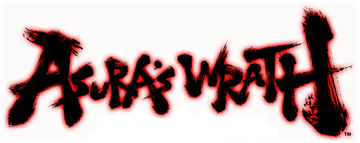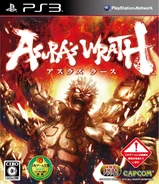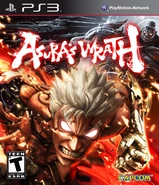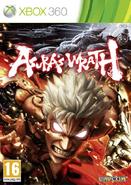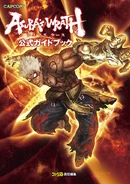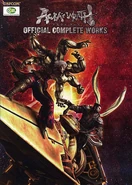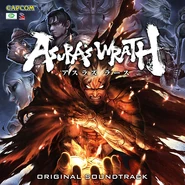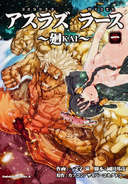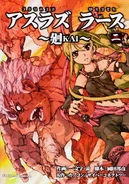Asura's Wrath (アスラズ ラース Asurazu Rāsu) is a 3D action beat 'em up game developed by CyberConnect2 and published by Capcom. The game was first announced at the Tokyo Game Show in 2010,[1] and was released worldwide in February 2012 for the PlayStation 3 and Xbox 360.[2] The game is also playable on Xbox One via 360 backwards compatibility, and the PlayStation 4 and PC via PlayStation Now.

Asura's Wrath - TGS 2010 Official Debut Trailer HD
The game follows the title character, the demigod Asura as he seeks revenge on the pantheon of other demigods who betrayed him and took away his daughter to use for their own antagonistic intentions. The story is presented in the style and format of an episodic series of cinematic scenes, including opening and closing credits, with the gameplay being integrated into the cinematic where players switch between third-person combat and interactive sequences with player input in the form of quick-time event button prompts. Because of its unique style, the game has been described in the media as an "interactive anime". Asura's Wrath takes elements from Hinduism and Buddhism and blends them with science fiction, with the main character based on the ever combative and superiority-seeking beings of the same name that are part of the Hindu and Buddhist cosmology.
Gameplay[]
The gameplay of Asura's Wrath is a combination of multiple genres, while overall is presented in the style of an episodic anime series. The gameplay throughout shifts between a third person action and a rail shooter game. The game also requires the player's direct input during cinematic events in the form of interactive cutscenes with various quick-time event and context sensitive button prompts.
In all forms of gameplay however, player progress is determined by two gauges represented at the top of the screen, the life and burst gauge. The life gauge determines the current health and damage taken by the character that if depleted results in a game over/restart screen for that current section. The burst gauge however starts empty at the start of every encounter that needs to be charged fully. In order to do this players must successfully defeat enemies, inflict large amounts of damage and press the current quick-time prompt correctly and in time. Once filled to maximum, players can unleash a powerful burst attack, which in the majority of cases is required in order to finish off strong opponents and advance the plot/gameplay, even commencing another cutscene. In addition to these two gauges, an additional one known as the "Unlimited gauge" fills up in a similar way to the burst gauge but instead can be activated to temporally increase damage that can be inflicted on opponents.[3]
The third person action sequences resemble beat 'em up style gameplay where the player must defeat enemies in close combat, utilizing light and heavy attacks, counters, dashes and projectiles. While regular light attacks are fast, heavier attacks inflict more damage and can throw back multiple enemies yet can overheat requiring a cool down period between uses. Players can also perform counter moves if they input the current prompt during an enemy's attack. When an enemy is knocked down, special moves can be performed that further help fill the burst gauge. If however the player character is knocked back, they have a chance to quickly recover by landing on their feet and saving additional health. The rail shooter portion of the gameplay involves the player character moving yet on a fixed axis, being only able to move to dodge and maneuver against incoming attack and obstacles, all the while locking on and firing upon enemies.[3]
The interactive cutscene element is integrated with the gameplay however. Correct inputs when prompted will advance the story while failure can cause the restart of a sequences and damage to health in a previous gameplay sequence. While a few sequences may continue regardless, certain quick-time events have degrees of success where the player may attempt to press at an even more specific time than when the prompt immediately and initially appears. For example, a press too early or later might register a merely "good" or "great" while the exact correct moment will register as "excellent". The player's performance in this aspect, along with time taken to complete and overall damage inflicted is graded at the end of each episode, with the highest grade being an "S Rank". At least five S Ranks or completing fifty episodes unlock the final hidden "true ending" of the game.
Presentation[]
Each level is played out as an episode more akin to an anime television series, with subtle introductory and closing credits at the start and end of each episode. This is then followed by a brief promo with cut together footage for the next episode, along with a narration recapping and foreshadowing upcoming events. In between episodes, there are also snippets of additional narrative and back story that are presented in the form of a series of illustrations, with each different segment drawn by a different credited artist. The entire "series" is split into four chapters, each cutscenes overlaid with lengthier production credits.[4]
Story[]
The story takes place on Gaea, a world inhabited by human tribes. The game opens as the world is overwhelmed and under threat by a demonic, destructive race known as the Gohma. Attempting to "purify" Gohma of their presence, the powerful and technologically advanced cyborgs-like deities known as the Eight Guardian Generals, led by Emperor Strada lead an immense fleet of warships to fight the Gohma. The protagonist Asura is one of these generals along with his mentor Augus, his rival/brother-in-law Yasha, Deus, Olga, Sergei, Wyzen, and Kalrow. As the generals engage in battle with the Gohma, Asura's daughter Mithra acts as the priestess of Shinkoku to empower him and the other generals to defeat the Gohma's source Vlitra who literally tears open the planet when it reveals itself. While only subdued, the generals claim victory over Vlitra. Back on Gaea, Asura is summoned by the Emperor only to find him dead upon arrival with the arriving guards accusing him of regicide and treason. A distraught Asura flees the palace after being forced to defend himself from Wyzen, returning to find his wife Durga fatally wounded as she dies revealing that Mithra was kidnapped. Asura eventually locates Mithra who is guarded by the other generals, Deus sending Asura to his death while revealing himself as the Emperor's murdered and that he will use Mithra to save the world.
Asura finds himself in the limbo of Naraka where a mysterious Golden Spider goads him into regaining memories and climb back into the mortal world. When he returns, 12,000 years have passed and Gaea’s situation hasn’t improved with the Gohma still causing destruction across the planet. There he confronts Wyzen who claims that the remaining generals have become the Seven Deities through the power of Mantra, a cosmic energy collected with the souls of their now human worshipers. Filled with rage upon remembering his past, Asura destroys Wyzen at the cost of his arms after a long battle before he is easily killed by Yasha who dropped him into molten rock. 500 years pass and Asura’s body has been excavated and worshiped by a small village, coming back to life as he encounters a young girl resembling Mithra. It is not long blatantly killing humans for Mantra. Asura manages to destroy Kalrow’s fleet before crushing him inside his own escape pod, learning from pleading deity that Deus intents to wipe out the Gohma for good.
Following this, Asura falls back to earth where he encounters Augus, who convinces him to drink and relax before they duel on the moon. Though Augus has the upper hand, Asura manages to break the sword and use the broken blade to gut Augus who dies satisfied with the duel. Asura returns to the village with the girl from before, but it is shortly bombarded by another fleet led by Olga. While Asura survives, he is overwhelmed with rage to find the girl has been killed. This causes Asura to transform into a demonic version of himself, becoming powerful enough to wipe out most the armada and forcing Olga to resort in using the deities' planet sized super weapon - The Brahmastra. But Yasha feels that using the weapon on Asura will only waste the thousands of souls collected for use against the Gohma, stopping the weapon in mid-fire, though Asura goes missing in the blast.
Following his actions, Deus orders Yasha under the supervision of Sergei to strike at the Gohma who are about to attack a human city. Despite Yasha’s best efforts to purify the Gohma before they can reach the city, Sergei bombards both them and the city for more souls. As Yasha has commanded from space most of the time, he only now realizes the needless mass slaughter of humans for Mantra. Asura then reappears, still consumed by rage and kills Sergei as he dies revealing himself as Durga's murderer. Realizing that Asura has become uncontrollable with rage, Yasha manages to subdue him back to his normal state as the two of them travel to Deus’s ship. They confront Deus where Yasha states that the cause is worthless if trillions had to die in the process while also at the cost of Mithra’s own suffering, shown to be drained of the Mantra she can collect and manipulate. Deus had apparently in the past warned the Emperor over Vlitra’s return but was dismissed, thus enacting his betrayal. Both Asura and Yasha battle Deus, with Asura nearly being uncontrollably consumed by rage once more but instead resists it despite indirect encouragement from the Golden Spider. Following a defeat, Deus with his last breath claims that only he could save Gaea where upon Vlitra returns once more, this time larger and more powerful. Asura and Yasha agree to battle it even at great odds, yet Mithra manipulates the Mantra in their aid where both of them break into the center then destroy Vlitra’s core. While Asura does not know whether it was truly defeated, he and Yasha return and reunite with Mithra.
But as revealed in the DLCs, unhinged by Deus's death, Olga attempts to kill Mithra in front of Asura. But the Golden Spider appears and kills Olga before taking residence in Mithra's body before sealing her away while revealing his true form Chakravartin, the Lord of Creation. Chakravartin states that he unleashed the Gohma to test Asura as a worthy inheritor of Gaea. Asura and Yasha attack Chakravartin only to find themselves outmatched and sent falling back to the planet. With Chakravartin proclaiming to destroy the world and remake it once more, settling things with Asura in a final duel, Yasha sacrifices himself to give his friend his Mantra Core and the Brahmastra's Mantra Reactor to use Mantra without destroying his body. While he heads into space, Chakravartin fires a doomsday blast at Gaea but Asura transforms into a near-godly form called Asura the Destructor and deflects it. Asura engages Chakravartin in a battle that causes the very fabric of time and space to come apart with all of creation. Chakravartin is eventually brought down by Asura's sheer force of will. Before Asura prepares to kill him, Mithra breaks free and urges him to stop since if Chakravartin is killed, all mantra-powered beings will cease to function, including Asura himself. Asura chooses to destroy Chakravartin nonetheless, so long as Mithra can live free from danger. As the landscape around him collapses, Asura shares his final words with Mithra and vanishes, free of his wrath for the first time. Mithra is sent back to Gaea, where she integrates with the surviving humans. She spends many years - centuries, given her demigoddess lifespan - recounting the tales of her father to the mortal children on Gaea.
The epilogue fast-forwards to 870 million years later, when a society resembling present-day has arisen. Asura is immortalized in the form of a great statue (resembling the Statue of Liberty), sitting in the bay outside a large city. Asura, Durga, Mithra, and the others have all been reincarnated as humans, living out happy lives still remarkably similar to their old incarnations: a father (Asura) is an angry man who promptly beats up a fat pedestrian (Wyzen) for accidentally knocking his daughter (Mithra) over, his wife (Durga) stands behind him to shield their daughter while gently scolding her husband, and the daughter watches the fight with glee as she admires her father's strength and fearlessness. A police officer chases an old man speeding along on a Segway (Kalrow) beneath a billboard showing off a video from a famous singer and model (Sergei). A rich businessman (Deus) scolds his secretary (Olga) for rushing them along when they see an elderly man (Strada) who is having trouble crossing the street, opting to be late for an important meeting in order to help him. The family meets up with the brooding uncle (Yasha) who still has issues with the angry fool his sister married, the subject of an ongoing rivalry between the brothers-in-law. As the family is reunited for a day on the town, a giant meteor appears in the sky, preparing to crash onto the city. While the others prepare to flee for shelter, the now-mortal Asura steps out into the middle of the street, bracing himself and clenching his fists, prepared to fight once again.
Characters[]
Playable[]
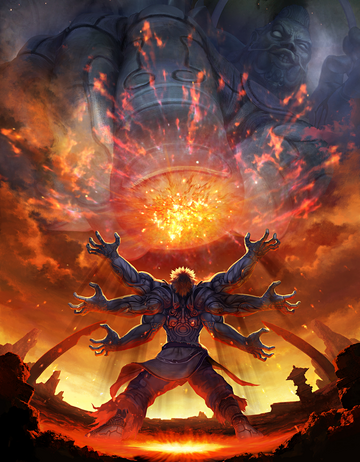
Promotional art.
Bosses and antagonists[]
Supporting/background characters[]
- Chun-Li - (cameo)
Enemies[]
- Preta
Bonus boss characters[]
- Ryu - (DLC) - "Lost Episode 1"
- Evil Ryu - (DLC) - "Lost Episode 1"
- Akuma - (DLC) - "Lost Episode 2"
- Oni - (DLC) - "Lost Episode 2"
Development[]
Asura's Wrath began development in 2007. Seiji Shimoda is director, Kazuhiro Tsuchiya the producer and Koki Yamaguchi is the artist. The development team wanted to create a game that everyone could understand. In an interview, Hiroshi Matsuyama commented on the principles behind the game's creation: "Our main concept was that we wanted to reach out to audiences all over the world with Asura's Wrath. That's why we focused on wrath as our main concept. It's something that anybody can relate to. It's an emotion that's very powerful. It's sometimes seen as negative, but it can be a driving force that helps you overcome any obstacle. When we came up with this backwards approach to the development process, first we thought of our focus on wrath, then focused on the story, so we built the story first. Who wrote the story? CyberConnect 2 did, as a group. It was a group effort throughout the dev team, but when we had the story, we passed that on to an actual script writer".[4] In a different interview, he went further into the game's core theme: "In Japanese entertainment and comics, and in games as well, there are many interesting depictions of wrath already – things like Dragon Ball and Naruto – and we love those kinds of comics and games. So we thought, what can we do if we really, really focus on that? How interesting can we make it? That was our challenge to ourselves".[5] The hotspring scene, a very traditional scene for manga and anime in Japanese culture according to Matsuyama, was deliberately placed as a change of pace and a chance for Asura to show a different face to players.[4]
The game was developed on the Unreal 3 engine, which was specially licensed by Capcom for the task, and aided significantly in development of the game. In an interview, Kazuhiro Tsuchiya stated that "We tried a lot of different options and determined that Unreal Engine 3 was a perfect solution. Our developers were able to review the game in real time, and they continue to be productive throughout the process".[6] Asura's Wrath was first announced during the Tokyo Game Show in September 2010. The announcement trailer showed the title character battle multiple enemies before being confronted by a planetary sized foe. The trailer showed an earlier build that differed from the finished product in multiple aspects. While the character designs and Asian-style art design were similar, even identical in certain regards, the tone and combat was more violent and bloody, showing a greater emphasis on the combat mechanics rather the interactive cinematic features.[7] Following its reveal, Tsuchiya revealed that he felt the game would serve to satisfy fans wanting a sequel to the 2006 PlayStation 2 game God Hand, which was lauded by critics, but failed commercially. He was later pleased that people had seen the deliberate similarities between the two games.[8] A playable demo was released on Xbox Live and PlayStation Network on January 10, 2012.[9] A playable demo was released on Xbox Live and PlayStation Network on January 10, 2012.[10]
Downloadable content[]
Downloadable content includes a two-dimensional fighting mode using the engine from the Street Fighter IV sub-series, as well as two characters from the Street Fighter series, Ryu and Akuma (and their respective "dark forms") as opponents. Also, "untold" chapters are included and use hand-drawn animation with quick time events, mostly to fill gaps between the game's chapters.[11] The DLC also allows the player to play and see the 'real' ending of the game which is not available from the disc.[12]
Music[]
The game's original soundtrack is scored by Chikayo Fukuda, and was released on March 7, 2012.[13][14] A track listing has been provided in Japanese.[15] In addition to the lead recording artist, other composers and pieces of music outside of development were involved. Chikayo Fukuda composed the main theme and its variation, entitled "In Your Belief" while the vocalized version was sung by Tomoyo Mitani. The game also featured Antonín Dvořák's Symphony No. 9 in E Minor From the New World in the set piece battle between Asura and Augus on the moon.
Reception[]
Asura's Wrath was received positively by the Japanese gaming magazine Famitsu, which gave the game scores of 10, 10, 9, and 9, each out of 10, adding up to a total of 38 out of 40.[16] When released in the Western market, critical reception of Asura's Wrath was mixed to positive, with many critics praising the story and highlighting the "interactive anime" style as a positive, while others felt it detracted from regular gameplay. Critical response to the balance between the "interactive anime" style and gameplay, as well as the reliance on quick-time events, were mixed.[citation needed]
Gallery[]
Box art[]
Merchandise[]
References[]
- ↑ https://web.archive.org/web/20111007040131/http://oxcgn.com/2010/09/15/capcom-announced-3-new-major-titles-incl-1-new-ip/
- ↑ http://www.computerandvideogames.com/335180/asuras-wrath-delayed-to-march/
- ↑ 3.0 3.1 http://www.gamespot.com/articles/tgs-2011-asuras-wrath-updated-preview/1100-6334708/
- ↑ 4.0 4.1 4.2 http://uk.ign.com/articles/2012/02/06/asuras-wrath-story-first-gameplay-later
- ↑ http://www.eurogamer.net/articles/2010-09-22-asuras-wrath-interview
- ↑ http://uk.ign.com/articles/2010/09/21/capcom-licenses-epic-games-unreal-engine-3-for-asuras-wrath
- ↑ http://uk.ign.com/articles/2011/04/12/asuras-wrath-the-basics
- ↑ http://www.eurogamer.net/articles/2011-04-18-asuras-wrath-satisfies-god-hand-2-cravings?comment_start=0
- ↑ http://kotaku.com/5874815/experience-asuras-wrath-first+hand-today
- ↑ https://kotaku.com/experience-asuras-wrath-first-hand-today-5874815
- ↑ http://uk.ign.com/articles/2012/03/28/asuras-wrath-dlc-details-2
- ↑ http://www.cinemablend.com/games/Want-Real-Ending-Asura-Wrath-Cough-Up-6-99-40917.html
- ↑ http://www.cdjapan.co.jp/detailview.html?KEY=CPCA-10256
- ↑ https://web.archive.org/web/20120503221621/http://senpaigamer.com/sony-playstation/asuras-wrath-visual-book-and-soundtrack-album-japan-02232012-1258
- ↑ http://vgmdb.net/album/30768
- ↑ https://web.archive.org/web/20120216001943/http://andriasang.com/comzyx/famitsu_scores/
External links[]
- Official site (Japanese)
- CyberConnect2's website (Japanese)

